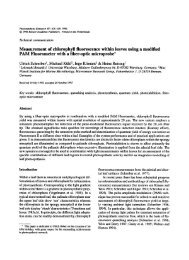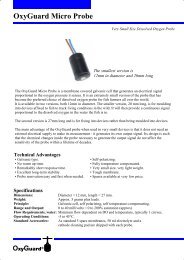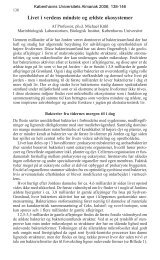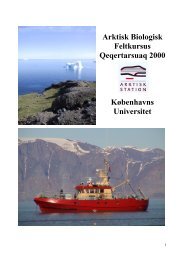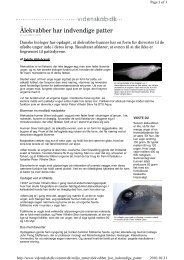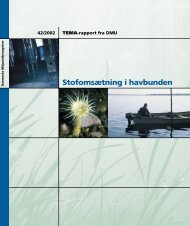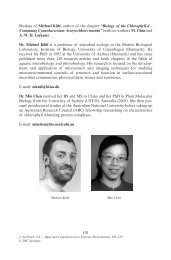Large Variabilities in Host Strain Susceptibility and Phage Host ...
Large Variabilities in Host Strain Susceptibility and Phage Host ...
Large Variabilities in Host Strain Susceptibility and Phage Host ...
Create successful ePaper yourself
Turn your PDF publications into a flip-book with our unique Google optimized e-Paper software.
VOL. 73, 2007 COMPLEXITY OF FLAVOBACTERIUM PHAGE-HOST INTERACTIONS 6737<br />
FIG. 7. UPGMA tree based on susceptibility to phages <strong>in</strong>fection. The data shown <strong>in</strong> Fig. 6 were scored <strong>and</strong> converted to pairwise distances<br />
us<strong>in</strong>g the Dice similarity coefficient. Group<strong>in</strong>gs of bacterial stra<strong>in</strong>s accord<strong>in</strong>g to UP-PCR <strong>and</strong> LPS profil<strong>in</strong>g <strong>and</strong> colony morphology are <strong>in</strong>serted<br />
to facilitate comparison.<br />
pr<strong>in</strong>t<strong>in</strong>g analyses of viruses with similar genome sizes may<br />
reveal an otherwise concealed genetic <strong>and</strong> morphological variation.<br />
This <strong>in</strong>dicates that analyses of natural viral assemblages<br />
based on genome size (i.e., PFGE) severely underestimate<br />
genetic diversity <strong>and</strong> viral community dynamics.<br />
Infection by the C. baltica phages appeared to be species<br />
specific, with a wide <strong>in</strong>traspecies host range (Fig. 6) <strong>and</strong> a<br />
tremendous variation <strong>in</strong> <strong>in</strong>fectivity of specific hosts (Table 3).<br />
This illustrates how phage community composition will have a<br />
large impact on the way that phages <strong>in</strong>fluence mortality as well<br />
as the species <strong>and</strong> stra<strong>in</strong> compositions of natural bacterioplankton<br />
communities. Further, s<strong>in</strong>ce phages with up to 10-<br />
fold differences <strong>in</strong> genome size were <strong>in</strong>fectious to the same<br />
host, it is possible that the extent <strong>and</strong>/or efficiency of transduction<br />
events (41) <strong>and</strong> phage conversion (9) <strong>in</strong> the environment<br />
will be highly dependent on <strong>in</strong>fection by specific phages.<br />
Stra<strong>in</strong>-specific susceptibility <strong>and</strong> resistance to phage <strong>in</strong>fection.<br />
While the C. baltica stra<strong>in</strong>s appeared to be genetically<br />
similar, they all showed a unique comb<strong>in</strong>ation of susceptibility<br />
TABLE 3. Efficiency of phage <strong>in</strong>fection <strong>in</strong> three bacterial stra<strong>in</strong>s<br />
Infection efficiency a <strong>in</strong> stra<strong>in</strong>:<br />
<strong>Phage</strong><br />
MM#3 #4 #10<br />
S T 100 14 0.001<br />
38:1 100 0.2 0.003<br />
40:1 100 1 0.0008<br />
a Stra<strong>in</strong>s were exposed to the same phage titer (10 8 PFU). Efficiency is<br />
expressed <strong>in</strong> relative PFU, where the highest PFU was set to 100%.<br />
to the tested phages. This was seen not only as the number of<br />
phages <strong>in</strong>fective to a given bacterial stra<strong>in</strong> but also <strong>in</strong> relative<br />
efficiency of <strong>in</strong>fection when different hosts were exposed to the<br />
same phage <strong>and</strong> titer (Table 3). Similarly, variable <strong>in</strong>fectivity<br />
has been observed for phages <strong>in</strong>fect<strong>in</strong>g different bacterial species<br />
(22). Therefore, the impact of phage <strong>in</strong>fection <strong>and</strong> lysis on<br />
a bacterial population is dependent not only on whether the<br />
phage can <strong>in</strong>fect the host but, just as importantly, on how<br />
susceptible the host is to <strong>in</strong>fection. In E. coli, acquisition of<br />
resistance, often associated with modification or loss of receptor<br />
molecules to which the phage <strong>in</strong>itially b<strong>in</strong>ds (5, 28, 43), may<br />
occur <strong>in</strong> one or two steps lead<strong>in</strong>g to the presence of partially<br />
resistant mutants (29). Hence, the specific mutation <strong>and</strong> receptor<br />
<strong>in</strong> question determ<strong>in</strong>e the extent of resistance. This<br />
complexity is also illustrated by acquisition of resistance <strong>in</strong> the<br />
C. baltica stra<strong>in</strong> MM#3. While resistance aga<strong>in</strong>st S M conferred<br />
resistance aga<strong>in</strong>st a large number of phages, resistance<br />
aga<strong>in</strong>st S T gave resistance aga<strong>in</strong>st only three phages with<br />
similar genome size (Table 2; Fig. 6). This suggests that different<br />
receptors are used by S M <strong>and</strong> S T .<br />
In E. coli the acquisition of resistance is often coupled to<br />
changes <strong>in</strong> the LPS structure, which are sometimes detectable<br />
by SDS-polyacrylamide gel electrophoresis (37, 56). Us<strong>in</strong>g this<br />
method, we found no differences between C. baltica stra<strong>in</strong>s,<br />
despite the fact that all showed unique susceptibility patterns,<br />
or between stra<strong>in</strong> 8 <strong>and</strong> the C. baltica stra<strong>in</strong>s. This calls the<br />
sensitivity of the method <strong>in</strong>to question; however, it cannot be<br />
excluded that susceptibility was determ<strong>in</strong>ed by cellular features<br />
other than LPS (e.g., cell surface prote<strong>in</strong>s) (29).




